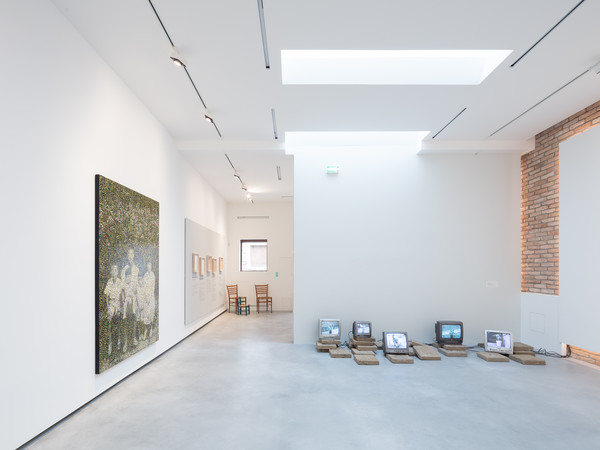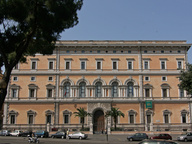to where the flowers are blooming

© gerdastudio | Gwangju Biennale Foundation installation view, Spazio Berlendis, Venezia
From 20 Aprile 2022 to 27 Novembre 2022
Venice
Place: Spazio Berlendis
Address: Calle Berlendis, Cannaregio 6301
Times: Tuesday to Sunday, 10am – 6pm
Organizers:
- Gwangju Biennale Foundation
- Città di Gwangju
Ticket price: free entrance
Official site: http://gwangjubiennale.org
The Gwangju Biennale Foundation and the City of Gwangju present "to where the flowers are blooming" 5.18 Democratization Movement special exhibition in Venice at Spazio Berlendis from April 20 to November 27, 2022.
A celebration of the 5.18 Democratization Movement, "to where the flowers are blooming" began in Seoul, Korea, in May 2020 and toured around Taipei, Cologne, and Gwangju to commemorate the 40th anniversary of the movement and reflect on the history and contemporaneity of the spirit of Gwangju, which drove Korea’s democratization.
After two years of postponement due to the coronavirus pandemic, the exhibition has now arrived in Venice, a city that has overcome the many challenges posed by its environment through will and community spirit to grow into a representative city of arts and culture. Reflecting on today’s humanity, the exhibition presents the spirit of Gwangju as explored through artistic language.
The title of the exhibition is borrowed from the phrase “to where the flowers are blooming” from the final chapter of Han Kang’s novel “Human Acts”, which deals with the lasting trauma of May 1980 on Gwangju and questions which historical memories must be most tightly held onto. The exhibition explores the will of human communities to rise above the vivid memories of anguish and historical tragedy and proceed forward toward a better world. Curated by the Gwangju Biennale Foundation’s exhibition department, “to where the flowers are blooming” is largely composed of three sections: an archive section that outlines the 5.18 Democratization Movement and the history of democracy in Korea, a section of commissioned works from the Gwangju Biennale, and a section on Gwangju’s spirit and contribution to Korea’s democratization.
The archive section curated by Yoo Kyoungnam, a researcher at the 5.18 Institute of Chonnam National University, introduces the legacy of the 5.18 Democratization Movement in Gwangju.
The second section composed of works commissioned by the Gwangju Biennale surveys the city’s history, memories, trauma, and spiritual heritage in line with its historical sites, and features works produced through intensive research on the city and the democratization movement. Kader Attia’s “Shifting Borders” sheds light on political and social irrationalities in history as it seeks remedies for the traumas caused in the process, while Ho Tzu Nyen’s “The 49th Hexagram” captures civil struggles and revolutions in Korean modern and contemporary history. Bae Young-hwan presents “Pop Song: March for the Beloved, ver.2”, a video installation incorporating paving blocks inscribed with lyrics from “March for the Beloved,” a song that has been frequently sung at democratization protests, including the 5.18 movement.
The third section, which reflects on the democratization movement in Gwangju and modern-day activism, begins with Hong Sung-dam’s “May Print Series”, which captures scenes from May 1980. The artist has compiled 50 woodblock prints documenting the movement and Gwangju residents at the time, adding a self-written poem to compose a book that tells the story of 5.18. Noh Suntag’s “Forgetting Machines” captures the fading portraits of Gwangju’s Mangwol-dong cemetery, where the victims of the 5.18 movement are buried, as a reminder of the passing of time and our ignorance of history. Ahn Chang Hong’s “Arirang Series" follows the traces of upheaval in Korean modern and contemporary history that have accumulated inside ordinary people. Choi Sun’s work containing human breath reminds viewers that democracy, like air, must be lived and breathed. “The Politics of Memory” by Jin Meyerson links a painting to a memorial site in Gwangju via an AR overlay to redefine communities and history in this age of social media by connecting memory and physical location. As Kim Chang-hun’s “SHINE: Gwangju Soundscape” brings to Venice sounds from major sites of the 5.18 Democratization Movement – the old Jeollanam-do Provincial Office, the commercial agent’s office, the 5.18 National Cemetery, and Chonnam National University – Park Hwayeon channels Gwangju residents’ memories of 5.18 through a reconstruction of the square in front of the old Jeollanam-do Provincial Office in the exhibition space. Meanwhile, Suh Dasom’s meal kit shares with viewers the history of Gwangju residents who made individual contributions to protect their community from the cruelty and horrors of May 1980. Alongside the exhibition, the Korean Cultural Center in Italy has organized an educational program that includes a discussion with novelist Han Kang for students in Italy who are interested in Korean culture and history. Students who participate in the program will get to introduce the spirit of Gwangju to exhibition visitors from a local Italian point of view. Having historically experienced that progress comes at a price, people pursue communal happiness and prosperity while contemplating from their own perspectives how to put the lessons of history into real practice.
At a time when humanity is facing various challenges accompanied by increased discrimination and hate, the 5.18 Democratization Movement Special Exhibition “to where the flowers are blooming” will serve as an opportunity for us to share our thoughts and seek future directions with artistic language and imagination as our media.
A celebration of the 5.18 Democratization Movement, "to where the flowers are blooming" began in Seoul, Korea, in May 2020 and toured around Taipei, Cologne, and Gwangju to commemorate the 40th anniversary of the movement and reflect on the history and contemporaneity of the spirit of Gwangju, which drove Korea’s democratization.
After two years of postponement due to the coronavirus pandemic, the exhibition has now arrived in Venice, a city that has overcome the many challenges posed by its environment through will and community spirit to grow into a representative city of arts and culture. Reflecting on today’s humanity, the exhibition presents the spirit of Gwangju as explored through artistic language.
The title of the exhibition is borrowed from the phrase “to where the flowers are blooming” from the final chapter of Han Kang’s novel “Human Acts”, which deals with the lasting trauma of May 1980 on Gwangju and questions which historical memories must be most tightly held onto. The exhibition explores the will of human communities to rise above the vivid memories of anguish and historical tragedy and proceed forward toward a better world. Curated by the Gwangju Biennale Foundation’s exhibition department, “to where the flowers are blooming” is largely composed of three sections: an archive section that outlines the 5.18 Democratization Movement and the history of democracy in Korea, a section of commissioned works from the Gwangju Biennale, and a section on Gwangju’s spirit and contribution to Korea’s democratization.
The archive section curated by Yoo Kyoungnam, a researcher at the 5.18 Institute of Chonnam National University, introduces the legacy of the 5.18 Democratization Movement in Gwangju.
The second section composed of works commissioned by the Gwangju Biennale surveys the city’s history, memories, trauma, and spiritual heritage in line with its historical sites, and features works produced through intensive research on the city and the democratization movement. Kader Attia’s “Shifting Borders” sheds light on political and social irrationalities in history as it seeks remedies for the traumas caused in the process, while Ho Tzu Nyen’s “The 49th Hexagram” captures civil struggles and revolutions in Korean modern and contemporary history. Bae Young-hwan presents “Pop Song: March for the Beloved, ver.2”, a video installation incorporating paving blocks inscribed with lyrics from “March for the Beloved,” a song that has been frequently sung at democratization protests, including the 5.18 movement.
The third section, which reflects on the democratization movement in Gwangju and modern-day activism, begins with Hong Sung-dam’s “May Print Series”, which captures scenes from May 1980. The artist has compiled 50 woodblock prints documenting the movement and Gwangju residents at the time, adding a self-written poem to compose a book that tells the story of 5.18. Noh Suntag’s “Forgetting Machines” captures the fading portraits of Gwangju’s Mangwol-dong cemetery, where the victims of the 5.18 movement are buried, as a reminder of the passing of time and our ignorance of history. Ahn Chang Hong’s “Arirang Series" follows the traces of upheaval in Korean modern and contemporary history that have accumulated inside ordinary people. Choi Sun’s work containing human breath reminds viewers that democracy, like air, must be lived and breathed. “The Politics of Memory” by Jin Meyerson links a painting to a memorial site in Gwangju via an AR overlay to redefine communities and history in this age of social media by connecting memory and physical location. As Kim Chang-hun’s “SHINE: Gwangju Soundscape” brings to Venice sounds from major sites of the 5.18 Democratization Movement – the old Jeollanam-do Provincial Office, the commercial agent’s office, the 5.18 National Cemetery, and Chonnam National University – Park Hwayeon channels Gwangju residents’ memories of 5.18 through a reconstruction of the square in front of the old Jeollanam-do Provincial Office in the exhibition space. Meanwhile, Suh Dasom’s meal kit shares with viewers the history of Gwangju residents who made individual contributions to protect their community from the cruelty and horrors of May 1980. Alongside the exhibition, the Korean Cultural Center in Italy has organized an educational program that includes a discussion with novelist Han Kang for students in Italy who are interested in Korean culture and history. Students who participate in the program will get to introduce the spirit of Gwangju to exhibition visitors from a local Italian point of view. Having historically experienced that progress comes at a price, people pursue communal happiness and prosperity while contemplating from their own perspectives how to put the lessons of history into real practice.
At a time when humanity is facing various challenges accompanied by increased discrimination and hate, the 5.18 Democratization Movement Special Exhibition “to where the flowers are blooming” will serve as an opportunity for us to share our thoughts and seek future directions with artistic language and imagination as our media.
SCARICA IL COMUNICATO IN PDF
COMMENTI

-
 Dal 31 gennaio 2024 al 04 maggio 2025
Fermo | Palazzo dei Priori
Dal 31 gennaio 2024 al 04 maggio 2025
Fermo | Palazzo dei Priori
-
 Dal 20 dicembre 2024 al 04 maggio 2025
Fermo | Palazzo dei Priori
Dal 20 dicembre 2024 al 04 maggio 2025
Fermo | Palazzo dei Priori
-
 Dal 20 dicembre 2024 al 04 maggio 2024
Gorizia | Palazzo Attems Petzenstein
Dal 20 dicembre 2024 al 04 maggio 2024
Gorizia | Palazzo Attems Petzenstein
-
 Dal 18 dicembre 2024 al 18 dicembre 2024
Venezia | Museo Correr
Dal 18 dicembre 2024 al 18 dicembre 2024
Venezia | Museo Correr
-
 Dal 14 dicembre 2024 al 02 marzo 2025
Palermo | Palazzo Abatellis
Dal 14 dicembre 2024 al 02 marzo 2025
Palermo | Palazzo Abatellis
-
 Dal 12 dicembre 2024 al 23 febbraio 2025
Roma | Palazzo Altemps
Dal 12 dicembre 2024 al 23 febbraio 2025
Roma | Palazzo Altemps


